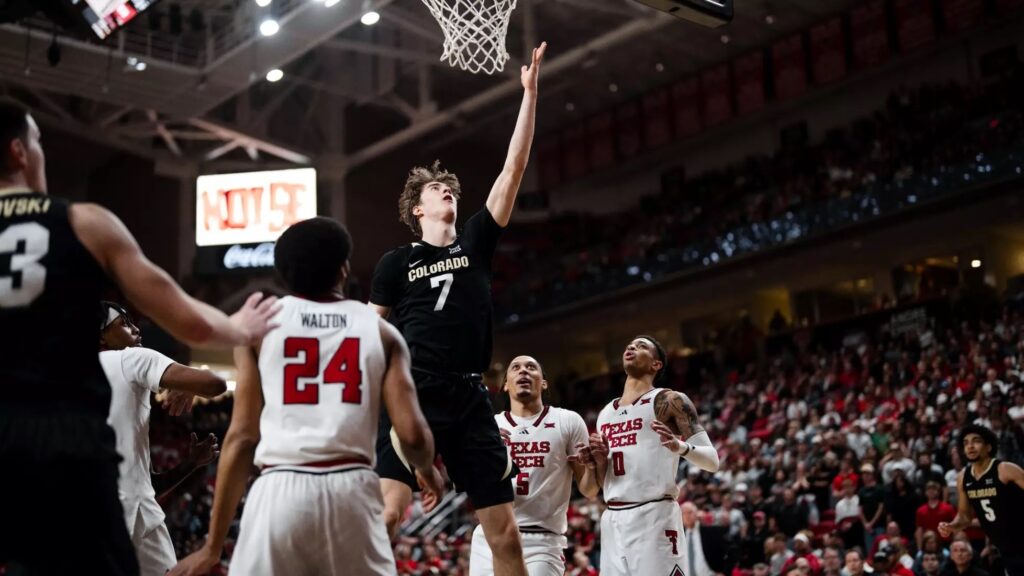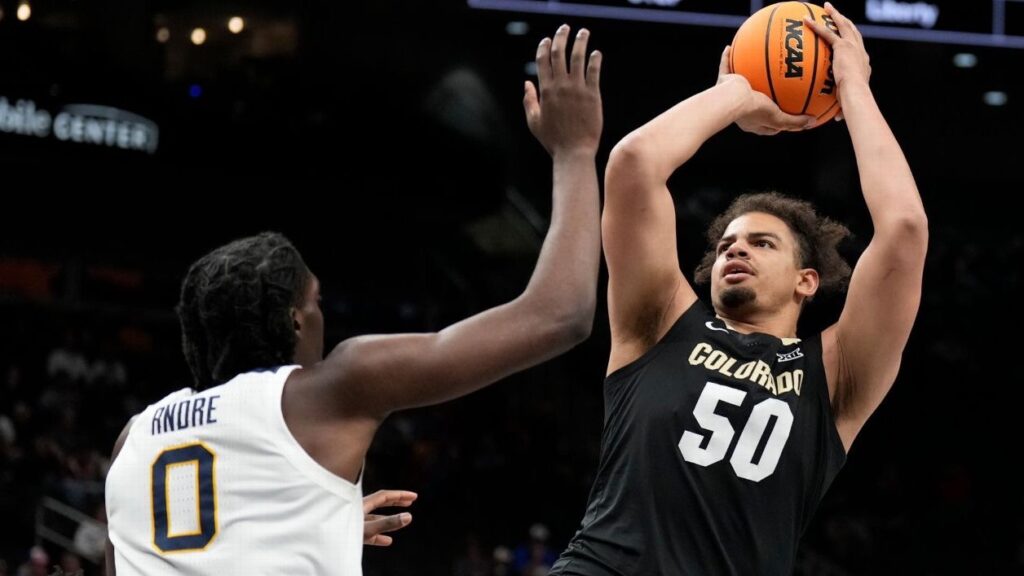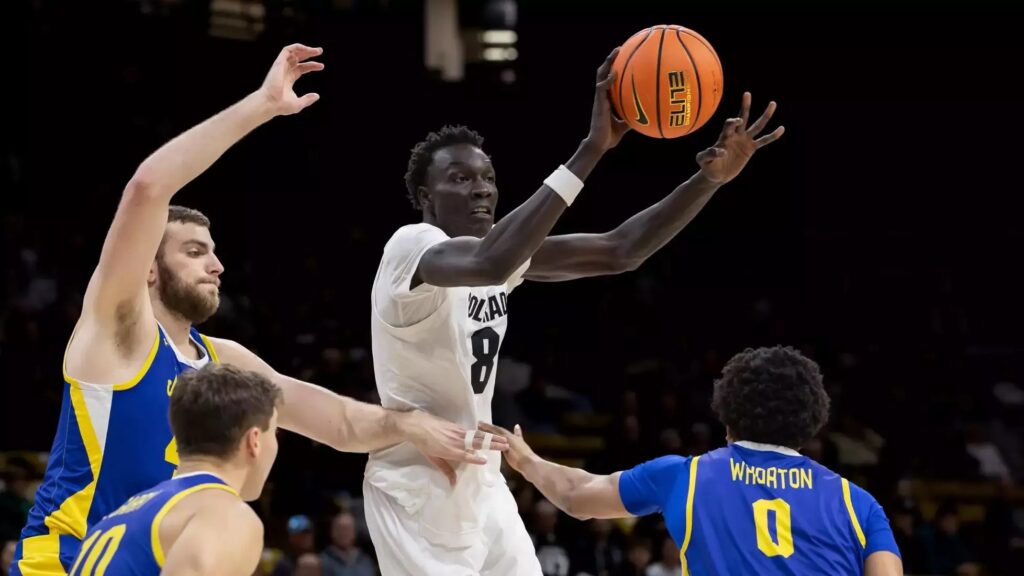
TL/DR: Colorado’s frontcourt faces an uphill battle in the Big 12. The Buffaloes lack proven size, rim protection, and physicality inside. Unless returning forward Bangot Dak makes a Tristan da Silva-like leap and Elijah “Post” Malone becomes a steady Big 12 center, CU’s frontcourt could be overmatched. The Buffs are still exploring one more late addition (7’1″ Italian Leonardo Van Elswyk has been recently added, for example) to give the team more height, but as things stand, this frontcourt must punch above its weight for Colorado to compete in 2025-26.
For the “Looks like a Basketball Roster: CU’s Backcourt” story, check out https://buffsblog.com/looks-like-a-basketball-roster-cu-backcourt/
Let’s evaluate.
Rough Minutes Breakdown
This is a rough projection of playing time once CU hits the conference schedule. In other words, this is how we project that Colorado’s coaching staff will divvy up minutes by the start of Big 12 season.
| Position | Projected Minutes (Primary/Secondary) |
| C | Post Malone 30, Tacko Fawaz 10 |
| PF | Bangot Dak 30, Sebby Rancik 10 |
| SF | Sebby Rancik 20, Josiah Sanders 10, Jon Mani 10 |
| SG | Felix Kossaras 15, Josiah Sanders 15, Jalin Holland 10 |
| PG | Barrington Hargress 30, Felix Kossaras 10 |
Also: Isaiah Johnson, Ian Inman, Andrew Crawford, Leonardo Van Elswyk.
CU returns a mix of familiar names in the frontcourt and new blood in the backcourt. The frontcourt rotation feels like it might hold up, but the backcourt? The backcourt does not bode particularly well for a successful Big 12 season.
Where’s the Beef?
As Tad Boyle enters Year 16 at Colorado, there’s one thing the program still hasn’t quite figured out: how to consistently pair defensive identity with modern offensive spacing in the frontcourt. And this year, it might get uglier before it gets better.
The 2025-26 roster is shaping up to be one of the smallest in Boyle’s tenure, especially after a recruiting class that leaned heavy on high school guards (four), returned only two backcourt contributors, and currently features zero high-major proven forwards. Though one roster spot remains open, CU will tip off summer practices with a very thin—and very unproven—frontcourt.
KenPom has long shown that elite rim protection, defensive rebounding, and interior scoring efficiency are non-negotiables for teams that want to sniff the second weekend of the NCAA Tournament. Last year, Colorado ranked 248th nationally in block rate (5.2%) and 286th in defensive rebounding percentage. This year’s frontcourt offers few signs that those numbers are trending up.
The Players
“Post” Malone – 6’10” Senior

The headliner of CU’s big-man rotation is Elijah Malone.
Last year, the Grace (Ind.) College transfer averaged 8 points, 3.2 rebounds and just over 1 assist per game. The 6’10” 285 pounder only played about 45% of CU’s minutes last season, and that number will increase significantly this season given Tad Boyle’s limited options in the post. Malone was a good scorer in the post when he got the ball — he shot over 62% from the field on 2 point field goal attempts, which ranked highly nationally. However, CU’s guards struggled to get the ball to him last year, and Malone isn’t dynamic enough as an athlete to create shots for himself anywhere other than in the paint. Malone only attempted 16 3-point shots last year.
Malone is a better offensive player than defensive player, where his lack of athleticism can hurt him. There is some chance that Malone’s defensive skills improve — at NAIA Grace (Ind.) College, the 2023-24 NAIA National Player of the Year averaged a 9.8% block rate, which would have ranked in the 90th percentile at the D-1 level if translated. Last year, however, that dropped to 3.8%, slightly above average but not in the same ballpark as his numbers at Grace. Of course, there’s a massive difference in competition. Still, Malone might be able to improve upon last year’s percentage as he gets used to playing against taller and quicker opponents.
Malone is a throwback center and Boyle has used throwback centers to some success before (see Josh Scott). Malone will need to give CU 30 minutes of post stability a game, which is a big ask. Defensively he’ll be targeted in space. Still, Malone is technically CU’s leading returning scorer and rebounder, and CU will need him to up his game even more.
Tacko Fawaz – 6’11” Freshman
Malone’s backup is true freshman Tacko Fawaz, and while the Buffs are high on his long-term potential, relying on him for 10 Big 12 minutes per night is asking a lot.
Fawaz brings raw length (7’4″ wingspan) and the outlines of a modern rim protector. In high school, he was a shot-swatting machine with a reported 12% block rate in his final AAU season. But he’s also rail-thin at 205 pounds and gets moved off his spot easily.
The good news: Fawaz is a willing runner, and his hands are decent. The bad: his timing is erratic, and his foul rate in high school was near 6.0 per 40 minutes. Expect a few highlight rejections and some foul-plagued performances. All of this underscores the need for more center depth.
Bangot Dak – 6’10” Sophomore

If there’s a wildcard in the frontcourt, it’s Bangot Dak. The 6’10” stretch-forward returns for his second year and is penciled in for starter-level minutes at the 4. Unfortunately, though, Dak is injured and missing all summer workouts. He won’t travel with the team to Australia for its trip this August against the Boomers, the Australian National Team. That’s not good for his development….and the team needs him to be healthy and take a big step this next season.
When healthy, Dak’s tools intrigue: 38.5% from three in limited action, a 6’11” wingspan, and enough lateral agility to switch onto guards. But he also posted a defensive rebounding rate under 12% last season and struggled mightily in physical matchups.
His KenPom profile was particularly harsh: a sub-100 offensive rating, usage under 15%, and a defensive BPM that dipped into the negatives when on the floor against bigger lineups. Dak has to bulk up and commit to defensive rebounding if CU wants to avoid getting bludgeoned on the glass again.
Still, the talent and potential is definitely there. Bangot Dak is a player that at times looks like the best basketball player on the court, and other times looks like he doesn’t belong on a basketball court.
The minutes are there for the taking. The question is whether Dak is ready for 30 high-major minutes per game in a conference where almost every team can throw two 6’9+ bruisers at you for 40 minutes. CU needs him to be healthy.
Sebastien Rancik – 6’8″ Sophomore
A tweener in every sense, Rancik will split time between the 3 and 4. He offers versatility and IQ, but he’s also emblematic of CU’s issues: talented but under-physical.
At 6’8″ and 210, Rancik has decent length and very good footwork, but he’s not a rim protector (0.3 blocks per game last year) and rarely impacts the game as a rebounder. His defensive rebounding rate was just 9.1% — well below the Big 12 average for combo forwards.
Offensively, CU will need Rancik to light it up. He’s proven that he can knock down open jumpers (33% from three), handle in transition, and move the ball. But his finishing around the rim was subpar, and he shot under 44% on two-pointers. He’s the classic floor-raiser who doesn’t solve your rim protection or physicality problems.
For CU to be competitive, the Buffs will need Rancik to take a leap this season. It’s possible.
Leonardo Van Elswyk – 7’1″ Freshman
Val Elswyk is a 7’1″ 220 pound center from Italy. Van Elswyk brings much-needed height, but at this point, CU needs more than a project. Van Elwsky is ranked the #25 player in his class in Italy by international scout Arman Jovik, which puts him right on the edge of being a D1 player. 247 reports no offers other than CU, although several schools (including the Unviersity of San Diego and Penn State) were sniffing around. Of course, you can’t teach height, and maybe Van Elswyk outplays scouts’ rather pedestrian expectations.
His tape shows different post moves and a nice shooting touch around the rim, along with some floaters and face-up jumpers. Occasionally, Van Elswyk popped out for a 3-point look, which had to be respected.
Still, he sometimes struggled guarding players in the Italian high school ranks, which does not bode well for him playing in the rough and tumble Big 12. He will need to work on his athleticism if he wants to play meaningful minutes in his CU career.
Van Elswyk is attempting to make Italy’s U20 national team. If he does make the team, he’ll be unable to travel with the team to Australia for the team trip this August. Paradoxially, making the team would probably set him back in his adjustment to basketball in the USA. Fans should expect a redshirt this season.
And the Rest: Will Help Arrive?
The remaining forward depth includes true freshman Jon Mani (6’6″) and Josiah Sanders (6’5″) — both more guard than forward. Boyle has been active on the international trail. CU is sniffing around another international post, and hopefully Boyle can land someone that can compete physically in the Big 12 right now.
CU needs someone who can grab eight rebounds, protect the rim, and hold up in pick-and-roll defense. Otherwise, the roster math doesn’t work. Not in the Big 12.
CU will once again face a brutal Big 12 schedule that includes Kansas, Iowa State, and Houston — all top-25 KenPom defenses and all teams with physical frontcourts that feast on the glass. CU’s current frontcourt rotation likely ranks at the bottom of the conference.
KenPom Forecast: Below the Fold
Even with the backcourt talent of Barrington Hargress, CU’s frontcourt is likely to drag down its ceiling. Using KenPom’s Four Factors model:
- Effective FG% Defense: Without a rim protector, expect CU to struggle with 2P% defense. Last year: 50.8% allowed (ranked 203rd nationally). Could get worse.
- Defensive Rebounding %: Unless Dak takes a huge leap, this remains a red flag. Rancik and Malone are average rebounders; Fawaz may get bullied.
- Block %: Only Fawaz projects as a shot-blocker. CU finished 248th last year; top-200 seems unlikely barring a surprise.
- Free Throw Rate Allowed: A sneaky concern. Young, foul-prone bigs like Fawaz and slow-footed ones like Malone often give up a lot of free throws.
The numbers paint a clear picture: CU’s frontcourt, as it stands, cannot survive a full Big 12 slate without reinforcements. The upside is minimal unless Sebby Rancik takes a leap, Dak becomes a rebounding force and Malone’s NAIA game somehow translates better than it did last year.
Final Word: Don’t Look Down
To be clear, Tad Boyle has done more with less before. He built top-40 defenses with rosters full of wings and undersized bigs. But this version of the Buffs is neither tall, nor physical, nor proven.
The schedule is manageable. But unless Fawaz or Van Elswyk drastically outperforms expectations, this team will get beat up down low. In a Big 12 that still features old-school post bruisers and switch-killing pick-and-rolls, the Buffs don’t yet have the answers.
One roster spot remains. CU’s season may hinge on how Boyle fills that spot.